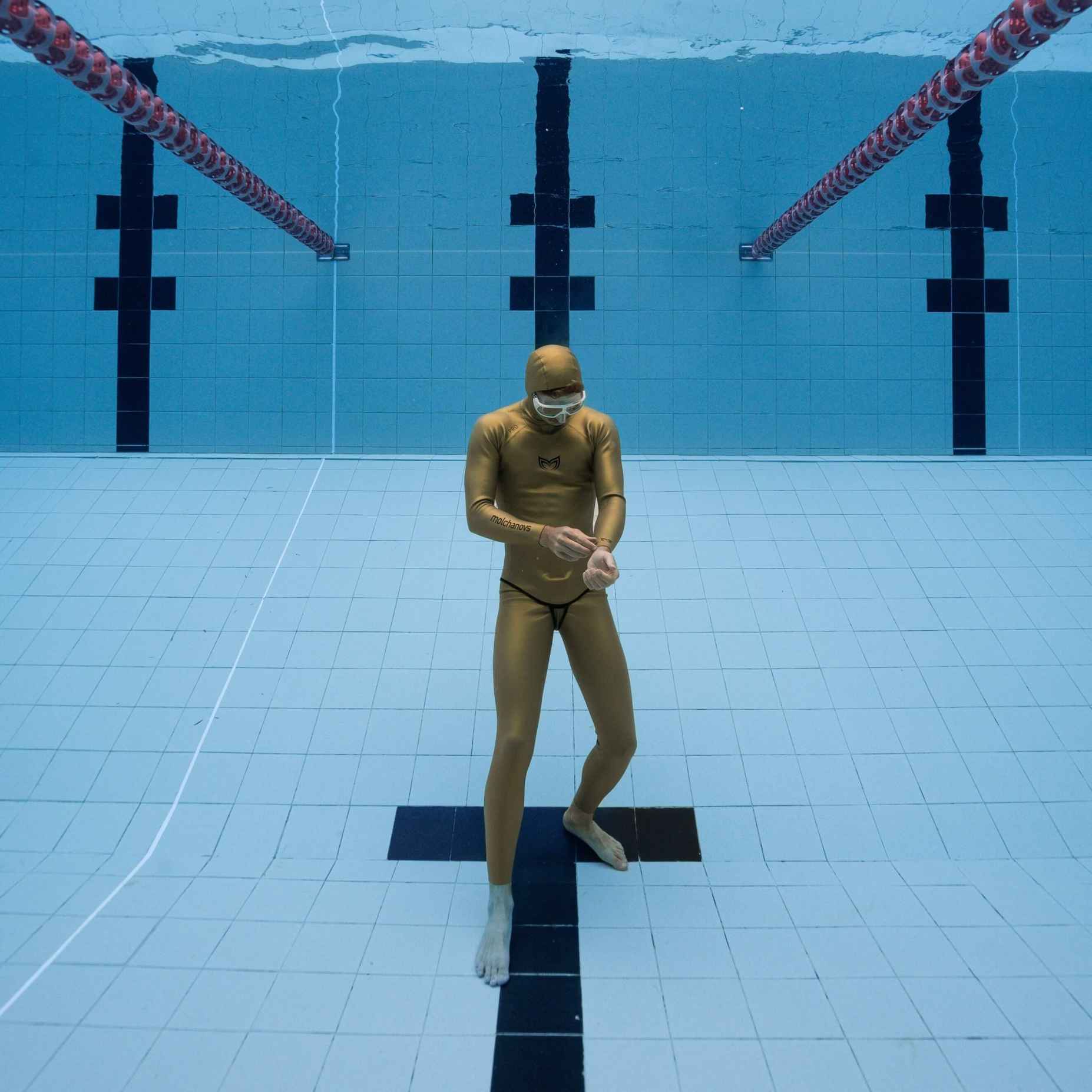Freediving Equipment for Beginners Guide

By Kristina Zvaritch
Contributors: Alexey Molchanov & Oli Christen
Freediving is a sport that is growing more and more popular by the year with the number of freedivers around the world multiplying quickly. After taking a certified freediving course, new freedivers may want to invest in their own equipment so as to avoid having to rent gear from a shop. The question is: what freediving equipment should beginners invest in?
Beginner freedivers should invest, at the very least, in a mask, a snorkel, and a set of bifins. A wetsuit, weight belt, weights, safety lanyard, socks, and gloves may also be needed depending on if you are training and where you are diving. Check out our guide below for more in-depth information on freediving equipment for beginners.
Mask

Check for a good fit by:
- Flipping the strap of the mask to the front and out of your way.
- Looking up.
- Placing the mask on your face without wiggling or pushing.
- Having someone check if there are any gaps between the mask and your face.
- If there are no gaps and you can make the mask stick to your face, it is a good fit.
- Make sure that you can equalize with the mask on and verify that your fingers have easy access to your nose.
If you purchase a mask with glass lenses, make sure to read the manufacturer label on your mask before the first use, as some masks come with an anti-fog layer. If there is no anti-fog layer, wash the inside of the mask lens with shampoo or toothpaste to remove the protective film. Plastic lenses do not have a protective film, but extra care must be taken with them as the plastic is highly prone to scratches; keep them in the box when you are not using them!
Check out the Molchanovs CORE freediving mask.
Snorkel
Freedivers use a snorkel for fun diving, resting during a training session, and supervising a buddy during their dive. The ideal snorkel for freediving has no valves or extra features; it is merely a simple, flexible snorkel that can be attached to your mask with a small strap.
Take a look at the Molchanovs CORE freediving snorkel.
Bifins
![]()
Freediving fins are traditionally long blades with soft foot pockets, worn with or without neoprene socks. Blades are usually made of plastic, fiberglass, or carbon fiber, although beginners should start training with rubber or silicone fins to work on forming good technique. While plastic fins are cheaper and more durable, they can be too stiff, which is not beneficial for forming good technique. It is better to start with silicone fins like the Molchanovs CORE Silicone Bifins, which are excellent for training proper bifin technique, traveling, and fun diving. Once a freediver is ready for a more premium pair of fins, they can look to purchase fiberglass or carbon fiber bifins.
Fiberglass fins are more expensive and delicate than plastic fins, but offer more options for stiffness and are more efficient. Carbon fiber fins are very expensive and extremely delicate, but are the most efficient for freediving and are preferred among freediving athletes.
Fiberglass and carbon fiber fins come in different blade stiffnesses, but are often a bit more difficult for beginners to use as they require good ankle flexibility. Soft bifins are recommended for beginners so as to save energy, minimize oxygen consumption, and improve technique. However, caution needs to be taken when transporting fiberglass and carbon fiber fins. Avoid pushing off of a pool wall or floor with your fins, leaving them in direct sunlight, and jumping into water with your feet flat and the blade parallel to the surface of water.
Explore our selection of Molchanovs bifins.
Silicone Monofin
![]()
Before committing to buying a premium monofin, beginner freedivers can first invest in a silicone monofin. Diving with a monofin is a completely unique experience that some describe as freediving in its purest form. The first freediving-specific silicone monofin, the CORE Silicone Monofin, is coming soon to Molchanovs and is already available for pre-order. With it, freedivers can feel differences in the balance, power, and coordination needed for the monofin technique, and will also find it perfect for fun diving and travel.
Take a look at the first freediving-specific Molchanovs CORE Silicone Monofin.
Wetsuit

Wetsuits may be needed by freedivers who are diving in non-tropical waters, as the human body loses heat 25 times faster in water than in air of the same temperature. Tropical waters may not require a full wetsuit, but are still recommened to protect freedivers from the sun and stinging creatures in the water.
Technically, a freediver could use a scuba or surfing wetsuit for freediving. However, scuba wetsuits use stiffer nylon in order to protect from general wear-and-tear, and surfing wetsuits are not meant to be put under pressure as they are designed to be used strictly on the surface of water. Freediving-specific wetsuits are designed specially for the sport, offering softness, flexibility, and pressure-resistance.
Beginners should look for a freediving wetsuit that is very close-fitting, or even custom-made to their measurements. Remember to take into account that a wetsuit that is too tight will restrict breathing, while a wetsuit that is too loose will flood with water and provide less thermal insulation. A hood is also beneficial for freedivers as it reduces loss of body heat through the head and provides sun protection for the head and neck. A two-piece wetsuit with high-waisted pants and a hood is recommended for its versatility in colder or warmer water temperatures.
Beginners should look for wetsuits with single- or double-lining, meaning that the neoprene is covered with a layer of elastic nylon. Open-cell wetsuits (naked neoprene on the inside and single-lining on the outside) are favorable for colder water temperatures. Check out our in-depth wetsuit guide for more information on wetsuits and for recommended wetsuit thickness according to water temperature.
Discover the different types of Molchanovs freediving wetsuits available.
Neoprene Socks and Gloves
Diving in cold waters might require neoprene socks and gloves to retain warmth in the extremities. Socks may also be used to keep your feet from getting blisters from bifin foot pockets. Look for socks and gloves that are double-lined with nylon for maximum durability. However, if you need maximum thermal protection, opt for open cell neoprene on the inside instead.
Weight Belt

Weight belts for freediving should be made of rubber or silicone, as opposed to the nylon belts used in scuba diving. Rubber and silicone belts are more elastic and are tightly stretched across the hips so that the belt does not slide when diving head-down; they also remain tight even as the wetsuit compresses with depth. Marseille (also called pin) buckles are considered the most reliable for their quick-release. Clasp buckles are also widely used, but are more at risk of accidentally opening. Metal buckles are recommended, but if plastic is used, it should be high quality plastic, otherwise it can be more prone to breaking.
Lead weights
Lead weights are used on the weight belt to compensate for buoyancy related to body composition and wetsuit thickness. Weights used for freediving should generally be smaller, 1kg or less, and evenly spaced out on the wetsuit. Make sure to use rubber-coated weights if you are practicing in a pool.
Beginners can check if their weighting is correct by using the surface exhale test:
- Float vertically at the surface of water while holding onto a float.
- Exhale deeply but without forcing all the air out of the lungs.
- Hold your breath on this exhale, relax your body (without kicking), and slowly let your hands slide off of the float.
- Check that you are not sinking. Your head may bob underwater, but you should not sink any further. If you sink further, grab the float or use your fins to come back to the surface, remove some weight, and repeat this test until you are no longer sinking.
Take a peek at the freediving-specific and anatomical Molchanovs Lead Weights.
Safety Lanyard

Safety lanyards are generally recommended - and mandatory in Molchanovs freediving courses - when diving deeper than 20m (66ft) or beyond surface visibility. They are also highly recommended when diving on a line after a course. Safety lanyards allow a freediver to close their eyes and focus on relaxation during a dive, keep line orientation, and make rescue situations far more safe and effective. In fact, in many possible emergency scenarios, a safety lanyard is the only means of safety.
A safety lanyard should be strong enough to hold your weight and made of marine-grade stainless steel to prevent rusting. The carabiner should be able to glide along a rope without snagging. A safety lanyard should also have a wide cuff and a quick-release in case of entanglement. Safety lanyards should be approximately 1m (3.3ft) long and made of non-twisting material, such as stainless steel wire enclosed in a plastic casing. Ideally, all safety lanyard parts and connections should be clearly visible for a visual inspection.
Check out the Molchanovs competition grade lanyard.
Equipment Care
Freediving equipment can be an expensive investment, so treat your gear with care. Make sure to rinse all of your equipment in fresh water after every freediving session, keep out of direct sunlight, and store in a cool, dry place.
There are many options for freediving equipment available online as the sport continues to grow in popularity. Equipment exists for every budget, so make sure to invest wisely and care for your gear to get the maximum enjoyment out of it, to prevent malfunction in the water, and to avoid having to constantly replace items.
Make sure to take a certified freediving course to learn correct freediving technique, proper safety training, and freediving theory. Always freedive with a trained buddy, never alone.





whant to get in to freediving and had to do reseerch it is amzing websit.
whant to get in to freediving and had to do reseerch it is amzing websit.
Very informative !!
Very good informative info for a newbie like me. Cheers.
Leave a comment